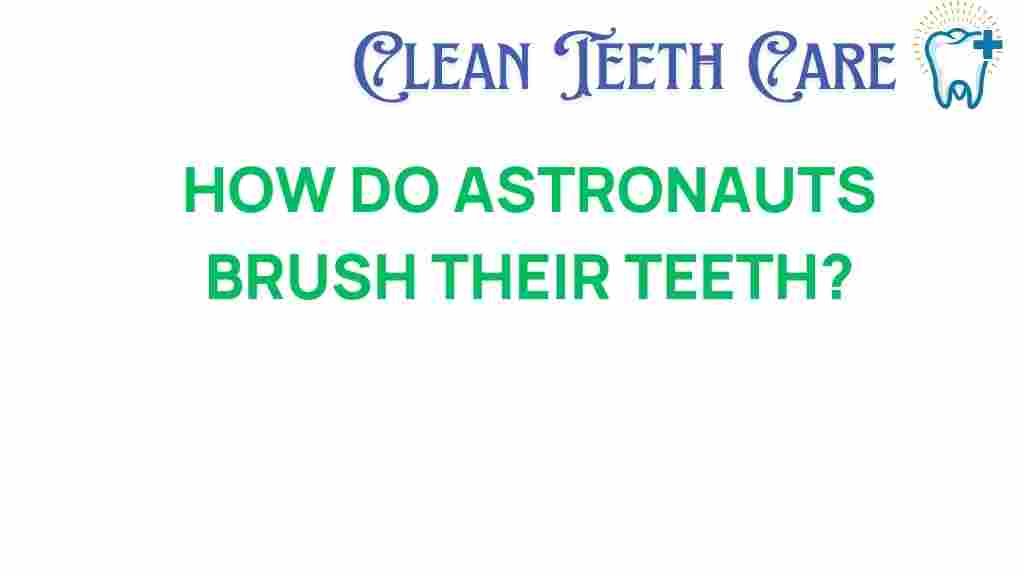The Cosmic Challenge: How Do Astronauts Brush Their Teeth in Space?
When we think of astronauts, our minds often drift to the vast expanse of space, groundbreaking scientific discoveries, and the awe-inspiring technology that allows humans to live and work in a microgravity environment. However, one aspect of life aboard the International Space Station (ISS) that doesn’t get as much attention is daily dental hygiene. How do astronauts maintain their oral care routine in a place where water behaves differently and everything floats? In this article, we will explore the unique challenges astronauts face when it comes to brushing their teeth in space, delve into the hygiene practices they follow, and highlight the importance of dental hygiene for space missions.
The Importance of Dental Hygiene in Space
Maintaining proper dental hygiene is crucial for astronauts. In a microgravity environment, the body undergoes various changes, and oral health can be affected. Here are some reasons why dental hygiene is particularly important during space missions:
- Health Risks: Poor dental health can lead to infections, which can be serious in space where medical facilities are limited.
- Comfort: Astronauts need to feel comfortable to perform their duties effectively, and dental issues can be distracting and painful.
- Mission Duration: Many space missions can last several months, making consistent oral care essential to avoid long-term health problems.
How Do Astronauts Brush Their Teeth in Space?
Brushing teeth in zero gravity might seem like a daunting task, but astronauts have developed a straightforward routine to keep their mouths clean. Here’s a step-by-step breakdown of how they manage their dental hygiene while floating in space.
Step 1: Gather the Necessary Supplies
Before starting their dental hygiene routine, astronauts gather the following supplies:
- Toothbrush: A specially designed toothbrush that can work in microgravity.
- Toothpaste: A non-foaming toothpaste that doesn’t require rinsing.
- Dental Floss: To maintain cleanliness between teeth.
- Disposable Towels: To keep the area clean and catch any floating debris.
Step 2: The Actual Brushing Process
Once the supplies are ready, astronauts follow these steps to brush their teeth:
- Positioning: Astronauts typically secure themselves in a designated area to avoid floating away while brushing.
- Applying Toothpaste: They place a small amount of non-foaming toothpaste directly on the toothbrush.
- Brushing Technique: Astronauts use a similar technique as on Earth, brushing in gentle circular motions to clean their teeth effectively.
- Spitting Method: Instead of rinsing, astronauts spit the toothpaste into a towel or a designated waste container, as water cannot be easily used in microgravity.
Step 3: Flossing
Flossing is also an essential part of their oral care routine. Astronauts use dental floss to remove food particles and plaque between their teeth. This step is crucial for preventing gum disease and maintaining overall oral health.
Step 4: Cleaning Up
After brushing and flossing, astronauts must clean up the area. They gather any used materials, such as towels and toothbrushes, and dispose of them properly to prevent any floating debris in the spacecraft.
Hygiene Practices Throughout Space Missions
NASA has developed specific hygiene practices to ensure astronauts maintain their health during long-duration space missions. These include:
- Regular Check-Ups: Astronauts have dental check-ups before their missions to address any potential issues.
- Emergency Dental Kits: The ISS is equipped with emergency dental kits to manage potential dental problems in space.
- Education on Oral Care: Astronauts receive training on the importance of oral hygiene and techniques to maintain it in microgravity.
Troubleshooting Tips for Dental Hygiene in Space
Even with a well-thought-out routine, astronauts may encounter challenges while maintaining their dental hygiene. Here are some troubleshooting tips to help manage those issues:
1. Toothpaste Issues
If the toothpaste is not dispensing properly:
- Ensure the toothpaste tube is not clogged. A gentle squeeze can help.
- If the toothpaste is too hard, warm it slightly by holding it in hand to soften it.
2. Floating Debris
Floating debris can be problematic during brushing:
- Use a towel to catch any particles and prevent them from floating away.
- Secure any tools or supplies before starting to minimize movement.
3. Oral Discomfort
If astronauts experience discomfort while brushing:
- Check for any issues with the toothbrush or floss, such as frayed bristles.
- If discomfort persists, consult medical personnel onboard or in mission control for advice.
Conclusion
In summary, maintaining dental hygiene is a significant challenge for astronauts in space. The unique environment of microgravity requires specially adapted tools and techniques to ensure that oral care is effective. With NASA’s meticulous planning and the astronauts’ commitment to hygiene practices, they successfully manage their dental health even in the vastness of space. As we continue to explore the cosmos, understanding and improving these aspects of life in space will be essential for the health and well-being of future astronauts. For more information on NASA’s hygiene practices and other fascinating aspects of space missions, visit NASA’s official site.
As we look forward to the next generation of space exploration, including missions to Mars and beyond, the importance of personal care routines, including dental hygiene, will undoubtedly remain a critical focus for astronaut health and safety.
This article is in the category Hygiene and created by CleanTeethCare Team
